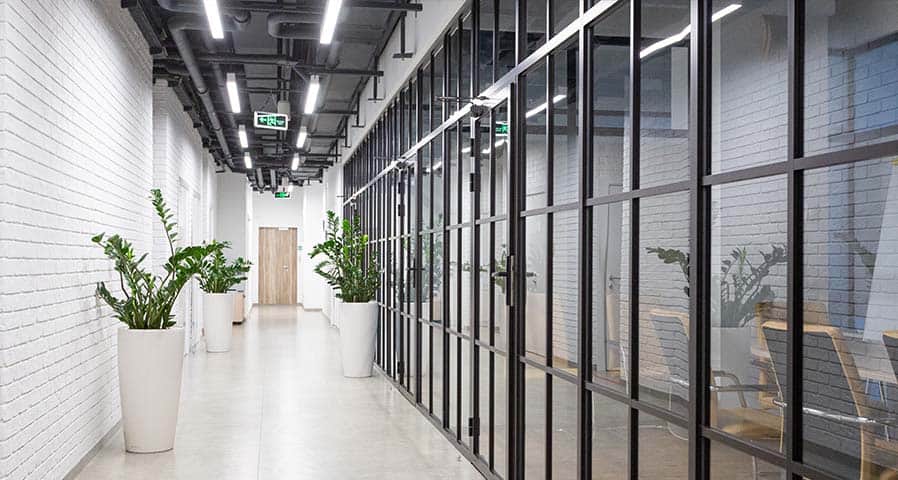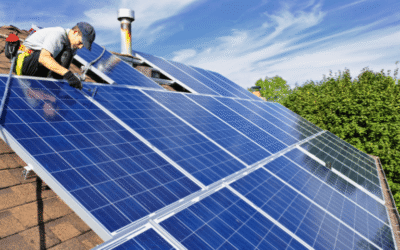Types of Lighting Controls for Office Buildings
Different types of lighting controls work best in specific situations. For example, occupancy sensors are a good choice in rooms that are not constantly occupied. Time scheduling sensors work best in large, open areas and you may want to use daylight sensors in rooms receiving plenty of natural light. Bi-level switches keep the lighting levels lower. However, not all controls are compatible with some types of light fixtures. Time scheduling controls are compatible with HIDs (high-intensity discharge) but daylight dimming, and occupancy sensors are not a good fit and we suggest retrofitting to LEDs.
Here’s a look at the characteristics of commonly used lighting controls in office buildings.
Occupancy Sensors
Occupancy sensors are common in office buildings. The sensors typically use either infrared or ultrasonic technology. Infrared sensors detect temperature changes in a room. These sensors are best suited for smaller areas where the controls can cover the entire room. Ultrasonic controls use high-frequency sound to detect motion. You can also use dual-technology controls to boost accuracy and placement flexibility, but these sensors also come with the highest price tag.
If you are new to lighting controls and are in the investigative stage our lighting controls blog feed has over 40 articles to help you understand what would work best for your facility. You might want to start with, Understanding Smart Lighting Controls Within your Facility.
Time Scheduling
Time scheduling controls are best suited for large, open offices. You can automate when the lights are on and off. Manual override features allow staff to turn the lights on after hours, typically using a wall switch or inputting a code. The scheduling can be done using computer controls or a standard clock. Businesses can further reduce electrical usage by designing the system to require the lights turned on manually and automatically shut off an hour or so after closing.
Bi-level Switching
Some employees may prefer lower light levels, especially in areas receiving plenty of sunlight. Lower light levels are typically preferred for meetings, computer use, or other tasks that are not visually demanding. Bi-level switching gives employees manual control over light levels. For example, employees can choose how many lights are turned on in multi-bulb fixtures. Some state energy codes require office buildings to use bi-level switching to reduce energy usage during peak hours.
Manual Dimming
Manual dimming controls are often used in areas requiring different light levels at varying times. Private offices and conference rooms are examples of spaces where manual controls work best. The controls can use a wireless remote or be wall-mounted.
Automatic Daylight Dimming
Automatic daylight dimming or daylighting controls use a sensor to measure the amount of light in an area. The light output from the dimming control is automatically adjusted to maintain the preset level of illumination. To increase the effectiveness of the sensor, it is often combined with task lighting controls.
Open cubicles and corridors with windows are good places to use automatic daylight-dimming controls. You can also install the controls in private offices and other rooms that receive daylight. To ensure maximum efficiency, calibrating the controls is necessary. Poorly calibrate controls often do not produce energy savings and can annoy room occupants.
Demand Lighting
Energy rates increase during peak hours but you can offset some of the cost with demand lighting controls. Being able to remotely control dimming sensors or bi-level switches will help you reduce energy consumption and avoid potential power outages.
Have you checked out our Lighting Control Education Center? We take an in-depth look at lighting controls, the different types, their benefits, different strategies, and the different lighting control categories. Click here to read more!
Reducing Energy Usage in Office Buildings
The right level of lighting depends on the type of tasks being performed, and employees’ preferences. The recommended light level for office buildings ranges from 30 to 60 footcandles, but environmental quality also affects illumination.
A well-designed office space with light-colored surfaces, task lighting controls, and placing furniture and light fixtures to avoid glare and shadows can lower electrical usage below average levels.
The placement and orientation of occupancy and daylight sensors are essential to reduce energy consumption. Take into account where the furniture is located to avoid interference with the controls. To avoid false-on issues, place occupancy sensors away from hallways. You also want to place daylight controls away from windows. It will help ensure the lighting levels are stable throughout the day. Don’t forget to select daylight controls that are easy to calibrate.
Choosing the right type of lighting controls and paying attention to their placement can help ensure you are seeing maximum energy savings.
Contact us today with your lighting control questions and let us help you create a lighting control system that benefits you and your employees. Call 610-558-9773, emailing [email protected], or schedule a call that fits your needs by clicking the button below.








































0 Comments